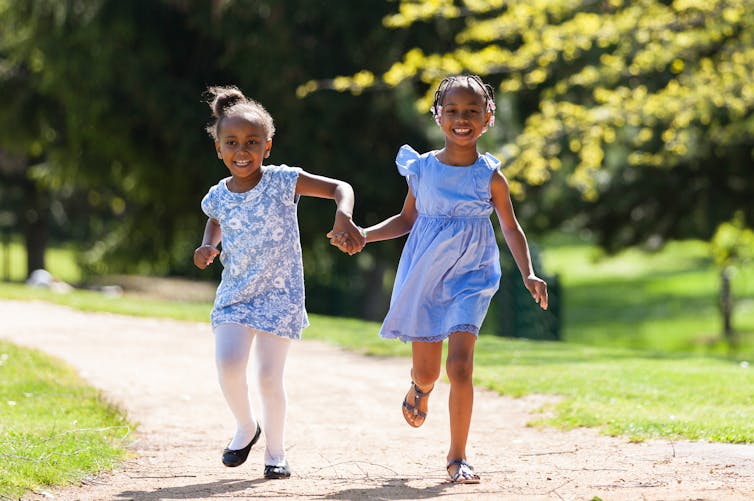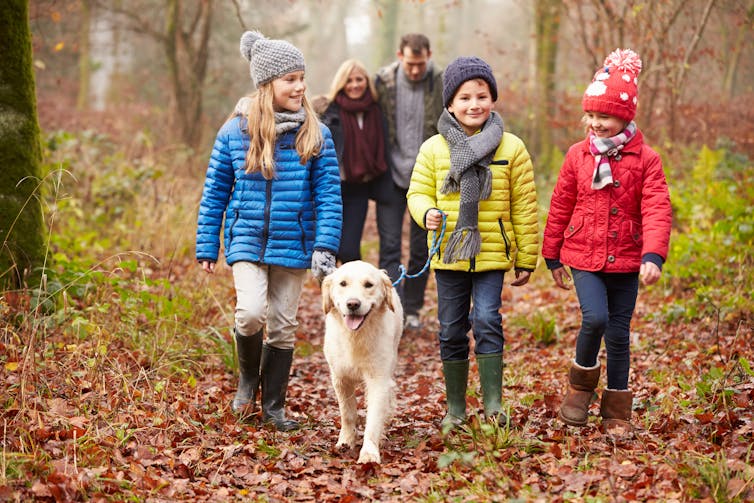ANURAK PONGPATIMET/Shutterstock
Lockdowns during the pandemic aimed to limit the spread of COVID-19 and related deaths. However, these lockdowns also affected how active people were. Children became significantly more sedentary.
There is a risk that short term changes in children’s physical activity in reaction to COVID-19 may end up extending beyond the duration of the pandemic. It is very easy for habits to become established, and for a more sedentary and less physically active lifestyle to become normal and ingrained in young people.
However, there are ways children can be encouraged to be more active. These include getting the whole family involved in physical activity and building exercise into a routine.
A global trend
Research from around the world has examined the extent that COVID-19 restrictions have had on children and their levels of physical activity.
Canadian researchers carried out an online survey of the parents of 1472 young people during COVID-19 restrictions. They found that only 4.8% of children aged five to 11 were meeting the Canadian 24-hour movement guidelines, which include an hour of moderate to vigorous physical activity daily. For young people aged 12 to 17, the number meeting the guidelines was just 0.6%.
Another study surveyed 211 parents of US children aged five to 13. It found that children spent about 90 minutes a day sitting down for school-related activities, and a further eight hours daily sitting down for leisure purposes during the pandemic.

Samuel Borges Photography/Shutterstock
A study in Shanghai, China compared the activity levels of 2,426 young people aged from six to 17 before and during the pandemic. It found that, overall, the amount of time the young people spent being physically active decreased drastically – from around nine hours a week to less that two hours a week. Screen time was up by approximately 30 hours a week on average.
The story was similar in Italy. Researchers compared the behaviour of a group of 41 children with obesity both before the pandemic and three weeks into Italy’s national lockdown. The time the children spent taking part in sports activities decreased during the pandemic, while sleep and and screen time increased.
Getting moving
Given the numerous physical and psychological benefits of increased physical activity, children should be given plenty of opportunity and encouragement to be physically active.
Family involvement plays an important role in children’s activity levels. Encouragement from parents, and parents taking part in physical activities with their children, is associated with higher indoor and outdoor child physical activity and play.
Research has also shown that having a pet dog can encourage children to be active.

Monkey Business Images/Shutterstock
One way to respond to the uncertainty of COVID is by developing routine and structure for children. Promoting a sense of predictability at home can go a long way in helping children cope with an uncertain world. Regular family walks at the weekend or after-school or exercise classes can be a really positive way of helping children to feel secure and nurtured.
One way that children enjoy staying active is by attending classes, from dance to swimming to football. During lockdown, these classes had to stop, but many have now reopened. They are a great way for children to socialise as well as keeping fit.
For some people, however, these classes are no longer an option. Some activities may be permanently closed, or families may have less disposable income than before the pandemic. Parents may be anxious about their children attending classes with other children.
Parental anxiety can have an impact on children’s physical activity. Children of parents who were more anxious in Canada visited the park less than children of less anxious parents during the pandemic.
During lockdowns, the cancellation of sports and activity classes have inspired programs offering online fitness classes for children. This is a great way of enabling children to be physically active at home in situations where their parents might not feel comfortable with them attending the large classes that they did before the pandemic.
It is really important for children to be physically active, and to stop a more sedentary lifestyle continuing into adulthood.
What did you think of this article?
Great | Good | Meh | Weak
![]()
Alison Owen does not work for, consult, own shares in or receive funding from any company or organisation that would benefit from this article, and has disclosed no relevant affiliations beyond their academic appointment.











